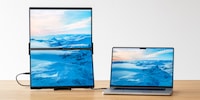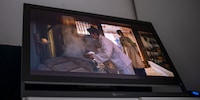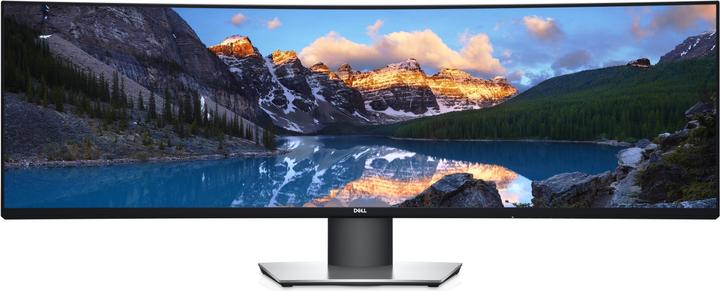
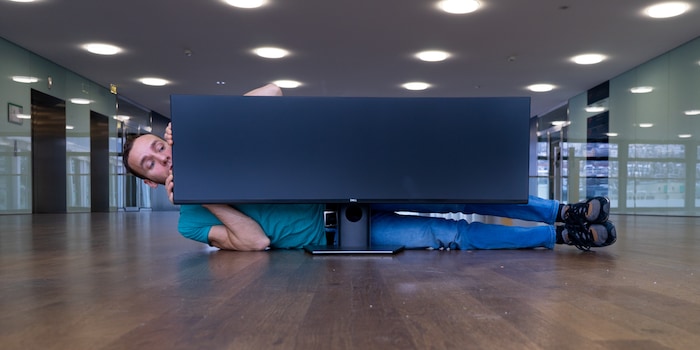
49 inches are perfect for the office
With its 32:9 aspect ratio, this monitor even overshadows cinema screens. Yet, Dell's intention isn't to enter the cinema business but to decorate your office. Having said that: Does anyone really want this?
«Wow, that’s what I call huge». This monitor comes in a box that's almost the size of my body. Okay, at 178 centimetres, I'm not exactly a giant, but still. It's a big box. I can't wait to take a picture of myself and this impressive monitor. While I'm posing, the following thought crosses my mind: This thing is a Lamborghini for tech nerds, including penis extension. Does this Dell monitor only look good or is useful, too? Let's find out.
This monstrous monitor has the following specs:
- 49-inch IPS display with 5120 x 1440 resolution (32:9 aspect ratio) and 60 Hz
- Contrast ratio of 1000:1
- Brightness: 350 cd/m²
- Colour depth: 10 bit
- SRGB colour space coverage: 99 percent
- Response time (grey to grey): 5 ms

IKEA-style assembling
I usually ignore the assembling part when I write a review of a monitor. Normally, all it takes is placing the display on the stand. That’s it. But with this monitor – it goes by the rather technical name U4919DW but I have decided to call it «Tiny» – things are a bit trickier. After opening the box, I see a cardboard cover with four compartments labelled from 1 to 4. It reminds me of the packaging of furniture from a certain Swedish store...
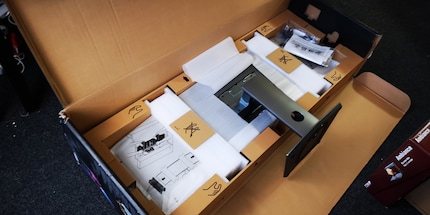
The first thing I have to do is put the stand on the base. That’s compartments 1 and 2 done with. Number 3 contains the VESA cover; number 4 various cables and manuals. As it turns out, I can now lift the cardboard cover and unveil the display. I tighten the screws at the back of the stand and base and heave the monitor onto my desk. And when I say «heave», I really mean it: Tiny weighs 17 kilograms.
When it comes to connectivity, Dell offers the following:
- 2 × HDMI 2.0 (HDCP 2.2) (10-bit colour @ 60 Hz)
- 1 × DP 1.4 (HDCP 2.2) (10-bit colour @ 60 Hz)
- 5 × USB 3.0 Downstream Port
- 2 × USB 3.0 Upstream Port
- 1 × USB Type-C (alternate mode for DP1.4,
power transmission and USB2.0) (8-bit colour @
60 Hz)
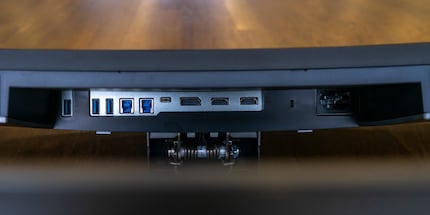
What I find interesting about this 49-inch monitor is the built-in KVM switch. If I connect several PCs to Tiny, I can control them with one mouse and keyboard. The efficiency junkie I am, I test this straight away.
One keyboard does the job
First off, I have to connect the keyboard and mouse to the downstream ports. Then, I connect a test notebook to the monitor via HDMI and USB upstream port. Finally, the office notebook with DisplayPort and USB-C is connected. That’s the theory of it. In reality, the included USB-C to USB-C cable is far too short. It measures only 100 centimetres. That’s by no means long enough, considering the port and the end of the monitor are 60 centimetres apart. So I need to relocate my docking station to connect the cable. How’s this supposed to work with a desktop? Too bad – at a cost of 1,500 francs, Dell could have included a longer cable.
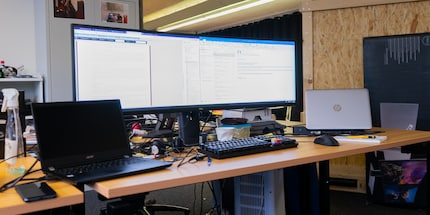
Anyway, what’s important is that I can try out the KVM switch now. After this, I get on with setting everything up. I access Tiny’s OSD and go to the menu point «Customise». This is where I can choose which functions the buttons should go with. I set button 1 to switching between the two USB downstream ports, which allows we to switch the mouse and keyboard from one computer to the other. After this, I activate picture-by-picture mode, select my two sources and assign them the corresponding USB downstream ports. This works and after five minutes, I can work in parallel on two computers with one monitor, one keyboard and one mouse each.
Intuitive menu control
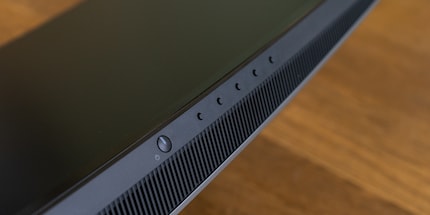
When it comes to operating OSDs, I prefer buttons to joysticks. I find it easier to control and less error-prone. Luckily, Tiny's OSD can only be operated with buttons. There are six of them on the left side of the monitor. The power button is a bit larger than the others, so it stands out a bit.
The other buttons are located to the right. The first three can be set to the control you wish; the fourth one takes you to the menu; the fifth one cancels what you’re doing.
The menu includes the usual settings such as brightness/contrast, colours, input source, display settings and menu options – and the special settings I described earlier. All in all, the controls are very intuitive and the menu items are easy to find.
Image quality ok but not exceptional
To get a first impression of the image quality, I carry out the Eizo monitor test. My test device has no pixel errors, reproduces greyscales evenly and has no tinge. The colour distances are reproduced well and the gradients are even. The viewing angle stability roughly corresponds to the promised 178°.
When it comes to colour space coverage, Tiny doesn't quite deliver the promised 99 percent sRGB. With the i1 Display Pro spectrometer by X-Rite, I measured about 97 percent sRGB and about 71 percent Adobe RGB colour space coverage with DisplayCal.
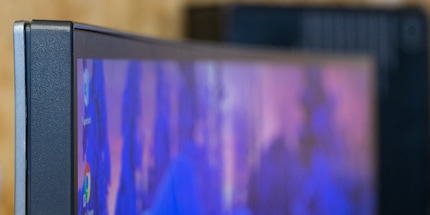
At 350 Nits, the brightness value this monitor offers is average. As long as the ambient light isn't too bright, it works well. I always worked with at least 80 percent of the maximum brightness. However, the display delivers solid values throughout. With the i1 Display Pro spectrometer by X-Rite, I measured about 350 percent sRGB and about 71 percent Adobe RGB colour space coverage with DisplayCal. There was only one area where I didn't measure the promised 350 cd/m2: the upper right corner of the screen.
An office monitor
With the specified colour space coverage of 99 percent sRGB, the monitor is hardly suitable for graphic designers or professional photographers. For amateur photographers, however, the colour space coverage is sufficient.
Tiny isn't ideal for gaming either. The 32:9 aspect ratio may be supported by many games nowadays, but with a grey to grey response time of 5 ms and 60 Hz, your possibilities are somewhat limited. In addition, the resolution of 5120 x 1440 pixels requires quite a bit of power. Having said that, this monitor could well be interesting for streamers who play less competitive games and work with a dedicated streaming PC. KVM allows them to display both systems on one monitor.
In my mind, this monitor is ideal for office work. Thanks to the 49-inch ultra-wide format, you get two 27-inch monitors in one while KVM means you only need one keyboard and mouse. Working on this monitor is really fun. However, at this price tag, you could buy four individual monitors and still have money left over. Which takes us back to the Lamborghini - there are a few things Tiny could (over)compensate for. Sure, it's an impressive monitor, but it's surely not the most sensible choice.
From big data to big brother, Cyborgs to Sci-Fi. All aspects of technology and society fascinate me.

